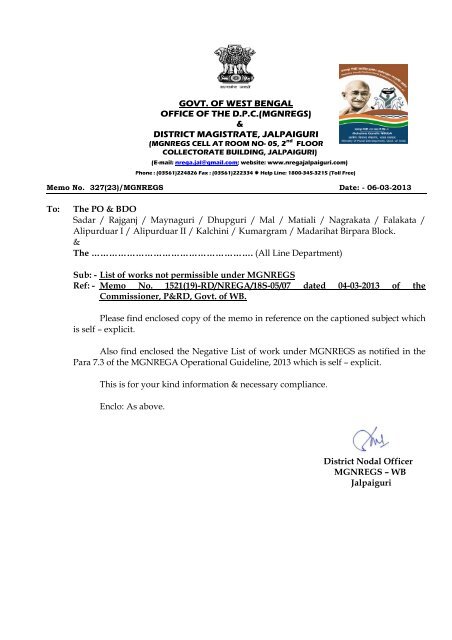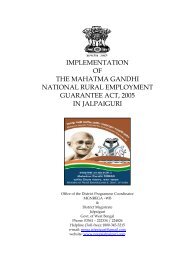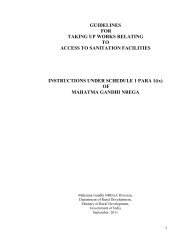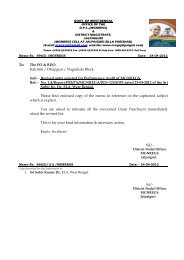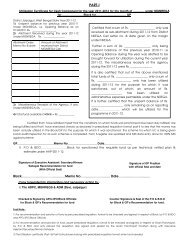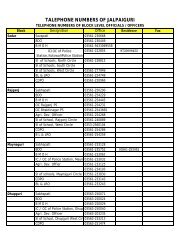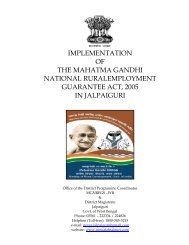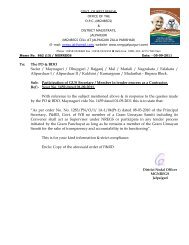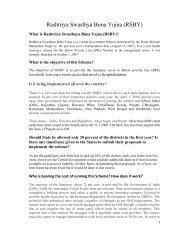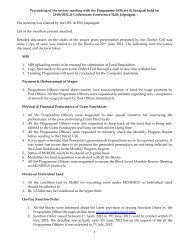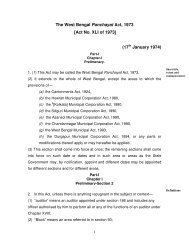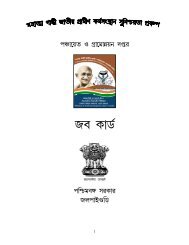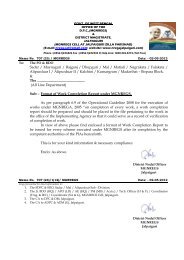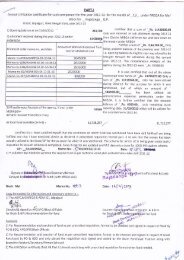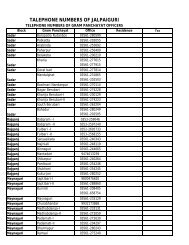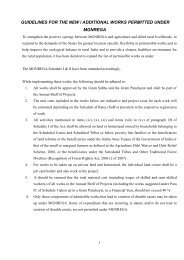List of works not permissible under MGNREGS - MGNREGA ...
List of works not permissible under MGNREGS - MGNREGA ...
List of works not permissible under MGNREGS - MGNREGA ...
Create successful ePaper yourself
Turn your PDF publications into a flip-book with our unique Google optimized e-Paper software.
GOVT. OF WEST BENGAL<br />
OFFICE OF THE D.P.C.(<strong>MGNREGS</strong>)<br />
&<br />
DISTRICT MAGISTRATE, JALPAIGURI<br />
(<strong>MGNREGS</strong> CELL AT ROOM NO- 05, 2 nd FLOOR<br />
COLLECTORATE BUILDING, JALPAIGURI)<br />
(E-mail: nrega.jal@gmail.com; website: www.nregajalpaiguri.com)<br />
Phone : (03561)224826 Fax : (03561)222334 Help Line: 1800-345-3215 (Toll Free)<br />
Memo No. 327(23)/<strong>MGNREGS</strong> Date: - 06-03-2013<br />
To:<br />
The PO & BDO<br />
Sadar / Rajganj / Maynaguri / Dhupguri / Mal / Matiali / Nagrakata / Falakata /<br />
Alipurduar I / Alipurduar II / Kalchini / Kumargram / Madarihat Birpara Block.<br />
&<br />
The ………………………………………………. (All Line Department)<br />
Sub: - <strong>List</strong> <strong>of</strong> <strong>works</strong> <strong>not</strong> <strong>permissible</strong> <strong>under</strong> <strong>MGNREGS</strong><br />
Ref: - Memo No. 1521(19)-RD/NREGA/18S-05/07 dated 04-03-2013 <strong>of</strong> the<br />
Commissioner, P&RD, Govt. <strong>of</strong> WB.<br />
Please find enclosed copy <strong>of</strong> the memo in reference on the captioned subject which<br />
is self – explicit.<br />
Also find enclosed the Negative <strong>List</strong> <strong>of</strong> work <strong>under</strong> <strong>MGNREGS</strong> as <strong>not</strong>ified in the<br />
Para 7.3 <strong>of</strong> the <strong>MGNREGA</strong> Operational Guideline, 2013 which is self – explicit.<br />
This is for your kind information & necessary compliance.<br />
Enclo: As above.<br />
District Nodal Officer<br />
<strong>MGNREGS</strong> – WB<br />
Jalpaiguri
7.3 NEGATIVE LIST<br />
7.3.1 Works like boulder, pebble or shrub removal, silt application and similar activities<br />
are <strong>not</strong> <strong>permissible</strong> as stand alone activities except when they are part <strong>of</strong> tasks in<br />
projects for converting uncultivable and barren / fallow lands into cultivable lands through<br />
one time land development and wherever land development is taken up, it may follow an<br />
area approach preferable a micro-watershed and <strong>not</strong> confined to a few individual<br />
holdings.<br />
7.3.2 Normal agriculture operations such as land preparation, ploughing, sowing, weed<br />
removal, turning the soil, watering, harvesting, pruning and such similar operations are<br />
<strong>not</strong> <strong>permissible</strong> in <strong>MGNREGA</strong>.<br />
7.3.3 Agriculture operations <strong>of</strong> any nature are <strong>not</strong> permitted to be taken up <strong>under</strong><br />
<strong>MGNREGA</strong> for food grain crops, vegetables, floriculture etc. The material cost for these<br />
<strong>of</strong> inputs (seeds, fertilizers, pesticide) would also <strong>not</strong> be covered <strong>under</strong> <strong>MGNREGA</strong>.<br />
7.3.4 Removal <strong>of</strong> weeds and watering may be considered for payment <strong>under</strong><br />
<strong>MGNREGA</strong> only for forestry plantations and horticulture limited for a duration <strong>of</strong> 2-3<br />
years. It is envisaged that at the end <strong>of</strong> this period, the horticulture plants would become<br />
fruit bearing and thereafter, weeding, watering etc would become a part <strong>of</strong> normal<br />
operations. Likewise, at the end <strong>of</strong> the 2-3 years, it is envisaged that the agro forestry<br />
plantation would attain sufficient height and should be able to survive with protection<br />
from grazing to be provided by ditch cum mound bunds along the periphery or other<br />
forms <strong>of</strong> physical structures. The State Agriculture / Horticulture/ Forest department<br />
would prescribe norms in respect <strong>of</strong> the duration and persondays for which removal <strong>of</strong><br />
weeds and watering etc for horticulture and forestry may be included as cost <strong>of</strong><br />
<strong>MGNREGA</strong> work. However, these norms should be the same as applicable to <strong>works</strong><br />
taken up <strong>under</strong> their own departmental programme either from state funds or as part <strong>of</strong> a<br />
CSS.<br />
7.3.5 Expenditure on <strong>works</strong> in the negative list would <strong>not</strong> be admissible and will be<br />
recovered from person(s) responsible for approving and executing the work.<br />
7.3.6 Pilots using <strong>MGNREGA</strong> funds should be taken up only upon approval <strong>of</strong> the<br />
Ministry and should be restricted to a few panchayats. Any decision on scaling up the<br />
pilots should also be taken only with due approval <strong>of</strong> the Ministry.<br />
7.3.7 The maintenance <strong>of</strong> assets should generally be <strong>under</strong>taken only for those <strong>works</strong><br />
and assets that have been created <strong>under</strong> <strong>MGNREGA</strong>. In case <strong>MGNREGA</strong> funds are to<br />
be used to rehabilitate assets created from schemes other than <strong>MGNREGA</strong>, the full<br />
details <strong>of</strong> previous work done along with date, copy <strong>of</strong> estimate and measurement book<br />
should be placed as part <strong>of</strong> the <strong>MGNREGA</strong> work record before administrative approval<br />
is granted. It will be the duty <strong>of</strong> the agency that has executed these assets to provide all<br />
required details and documents to the GP . PO will ensure that an entry to this effect is<br />
made against each such work in the list <strong>of</strong> <strong>works</strong> placed before the GS. S/he will ensure<br />
that copies <strong>of</strong> documents are also made available to the DPC before administrative<br />
approval is accorded and details are made available to the implementing agency along<br />
with the work order.<br />
7.3.8 <strong>MGNREGA</strong> funds can<strong>not</strong> be used for land acquisition. Land belonging to all<br />
categories mentioned <strong>under</strong> paragraph 1C <strong>of</strong> Schedule 1 can<strong>not</strong> be acquired for <strong>works</strong>
<strong>under</strong> the <strong>MGNREGA</strong>. In case land is being donated for <strong>MGNREGA</strong> <strong>works</strong>, DPC should<br />
ensure donation is entirely voluntary and <strong>not</strong> <strong>under</strong> due pressure.<br />
7.3.9 A major activity that has been widely <strong>under</strong>taken <strong>under</strong> <strong>MGNREGA</strong> is the<br />
construction <strong>of</strong> wells. However, it has been observed that on many occasions, this has<br />
been done in an indiscriminate manner without reference to the prevailing hydrogeological<br />
conditions and the possible impact on the already receding, water table and<br />
water quality. Groundwater is a common pool resource. Extraction <strong>of</strong> groundwater<br />
through individual sources such as wells and tubewells can sometimes threaten the<br />
quantity (depth) and quality <strong>of</strong> the resource.<br />
The following conditions are, therefore, being prescribed for <strong>under</strong>taking digging<br />
<strong>of</strong> wells <strong>under</strong> <strong>MGNREGA</strong>:<br />
i) Bore wells and tube wells will NOT be considered as a <strong>permissible</strong> activity<br />
<strong>under</strong> <strong>MGNREGA</strong>, <strong>under</strong> any circumstances.<br />
ii)<br />
iii)<br />
iv)<br />
Digging <strong>of</strong> private wells will <strong>not</strong> be a <strong>permissible</strong> activity <strong>under</strong> <strong>MGNREGA</strong> in<br />
areas which have been classified as semi-critical or critical or over exploited<br />
according to Central Government Water Board’s (CGWB) latest assessment.<br />
In areas which have been classified as semi-critical or critical or over<br />
exploited according to CGWB’s latest assessment, only “group wells” will be<br />
allowed where a group <strong>of</strong> farmers agrees to share the water from such a<br />
“group well”. Each such group will comprise at least 3 farmers.<br />
There should be a formal agreement (on Stamp Paper) between farmers for<br />
water sharing from a group well. Verification <strong>of</strong> the agreement within this<br />
group will be through the GP.<br />
v) Only one member from one family can be the member <strong>of</strong> the group. He/she<br />
can<strong>not</strong> be members <strong>of</strong> more than one group.<br />
vi)<br />
vii)<br />
A Group Well should be registered as a Group Irrigation Well in revenue<br />
records.<br />
In areas classified as “safe” by the CGWB, individual wells may be<br />
considered. Depth and diameter <strong>of</strong> such wells and well to well spacing must<br />
conform to the hydrogeology <strong>of</strong> the area. In hard rock areas, diameters must<br />
be kept within 8m. For s<strong>of</strong>ter rock and alluvial areas, well diameter must be<br />
less than 6m.<br />
7.3.10 States must seek clearance from the Ministry whenever there is any doubt about<br />
an activity being <strong>permissible</strong> or <strong>not</strong> <strong>under</strong> <strong>MGNREGA</strong>.


